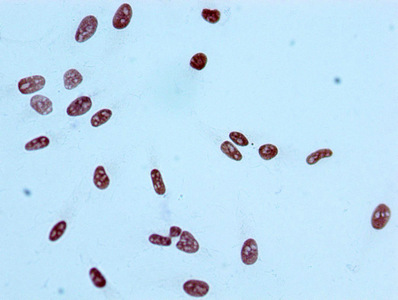
Immunocytochemistry analysis of CSB-RA010385A09acHU diluted at 1:100 and staining in Hela cells performed on a Leica BondTM system. After dewaxing and hydration, antigen retrieval was mediated by high pressure in a citrate buffer (pH 6.0). Section was blocked with 10% normal goat serum 30min at RT. Then primary antibody (1% BSA) was incubated at 4°C overnight. The primary is detected by a biotinylated secondary antibody and visualized using an HRP conjugated SP system.
Acetyl-Histone H2A type 1-B/E (K9) Recombinant Monoclonal Antibody
CSB-RA010385A09ACHU
ApplicationsImmunoFluorescence, ELISA, ImmunoCytoChemistry
Product group Antibodies
ReactivityHuman
TargetH2AC8
Overview
- SupplierCusabio
- Product NameAcetyl-Histone H2A type 1-B/E (K9) Recombinant Monoclonal Antibody
- Delivery Days Customer20
- ApplicationsImmunoFluorescence, ELISA, ImmunoCytoChemistry
- CertificationResearch Use Only
- ClonalityMonoclonal
- Clone ID3H5
- ConjugateUnconjugated
- Gene ID3012
- Target nameH2AC8
- Target descriptionH2A clustered histone 8
- Target synonymsH2A histone family, member A; H2A.1; H2A.2; H2A/a; H2AC4; H2AFA; HIST1H2AE; histone 1, H2ae; histone cluster 1 H2A family member e; histone cluster 1, H2ae; histone H2A type 1-B/E; histone H2A/a; histone H2AE
- IsotypeIgG
- Protein IDP04908
- Protein NameHistone H2A type 1-B/E
- Scientific DescriptionCore component of nucleosome. Nucleosomes wrap and compact DNA into chromatin, limiting DNA accessibility to the cellular machineries which require DNA as a template. Histones thereby play a central role in transcription regulation, DNA repair, DNA replication and chromosomal stability. DNA accessibility is regulated via a complex set of post-translational modifications of histones, also called histone code, and nucleosome remodeling.
- ReactivityHuman
- Storage Instruction-20°C or -80°C
- UNSPSC12352203

